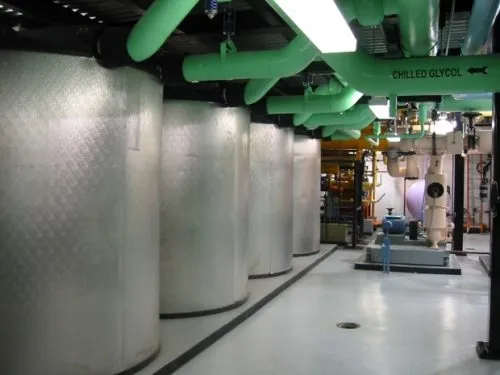
September 21, 2016
To Beat City Heat, Use an ‘Ice Battery’


September 21, 2016

Famously, Americans are the world’s most extravagant consumers of artificial cooling: We use more electricity for air-conditioning than the entire continent of Africa uses for, well, everything. And as global heat records keep falling and summers get longer and hotter—and as the use of A/C proliferates worldwide—that demand will continue to surge.
The challenge of keeping cities livable as we chug toward our Venusian future is complicated by the fact that A/C use fuels rising temps, both directly and indirectly. To handle the increased power demands of hot summer days, utilities need to fire up those dirty, carbon-intensive “peaker plants” that emit an extra dose of climate-addling gases. Plus, because the electrical grid can’t just store the extra juice we need to crank the A/C when a heat wave comes, an enormous amount of energy is wasted on rarely needed capacity. “We have twice as much transmission as we need to meet our needs, if we were using it at a steady rate, day and night,” says Mark MacCracken, CEO of CALMAC, a New Jersey firm that specializes in thermal energy storage.
MacCracken thinks his company has at least part of the answer to the question of how to break the air-conditioning feedback loop: freezing huge tanks of water at night, when off-peak electricity is both comparatively cheap and clean, and then using all that ice to run air-conditioners during the day. In effect, the giant slushies operate like batteries, warehousing thermal energy for use later. “You can’t store light. You can’t store moving air. But you can store cooling. It’s the low-hanging fruit of the whole system.”
Cooling via basement ice storage isn’t new: The same basic idea was used in colonial-era icehouses, and in movie theaters during the 1930s, before modern commercial A/C was in wide use. It’s basically an industrial-scale version of thebowl-of-ice-cubes-in-front-of-a-box-fan technique that you tried in your first apartment. But this one actually works.
Cal MacCracken, jet engine pioneer and air-conditioning innovator
MacCracken credits his father for the idea: Company founder Calvin, a former General Electric engineer who holds more than 80 patents (including one forthose weenie-rollers that cook hot dogs at convenience stores), came up with the technology during the Carter Administration, during a temporary flurry of national interest in green energy. CALMAC has been using it successfully in commercial buildings since 1979. Its new system in the new Goldman Sachs Tower in New York City freezes 1.7 million pounds of ice every night in 92 basement tanks.* A rival firm, Ice Energy, uses similar technology to run cooling systems for both residential and commercial applications. The principle is simple and elegant, since an ice battery has no moving parts and doesn’t corrode or wear out like chemical batteries. (Other energy storage techniques, such as those involving flywheels, submerged compressed air, and superheated argon gas, seem to involve a higher potential for spectacular failure.) Once installed, the equipment just sits there, melting and freezing; the second law of thermodynamics does all the heavy lifting. “You know all that mass we took out of buildings when we took the granite walls away? We’re giving that mass back, but we’re putting it in the basement and making it controllable,” MacCracken says. “It’s like this giant damper.”
The CALMAC boss is also trying to encourage regulatory incentives that would make thermal storage a player in a larger transformation: the shift from a primarily fossil-fuel powered grid to one based on renewables like wind and solar. One of the many challenges involved in scaling up carbon-friendlier energy is unreliability: How do you keep feeding the voracious grid when the sun goes down or the wind dies? Despite furious innovation and big promises from Tesla and others, large-scale battery-based residential power infrastructure is still in the future. And renewable energy is fundamentally hard to collect in urban environments—wind turbines are foiled by buildings getting in the way, and rooftop solar doesn’t always fit in a vertical city. Luckily, several major cities in the U.S. are conveniently situated next to a big windy ocean.
“If you look at the big picture of renewables, they need to have storage if they’re going to replace fossil fuels,” says MacCracken. “You build offshore wind to collect it, distribute the power to the city, and store it in the dense urban area. Because that’s where you’re going to use it.”
Like so many civilization-saving schemes, it all sounds simple enough. We’ll see if the idea gets a chilly reception.
This article retrieved from: CityLab.com
